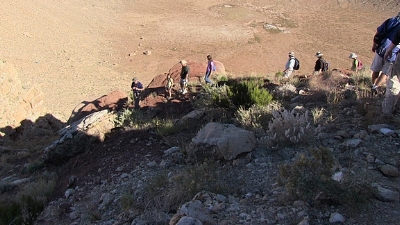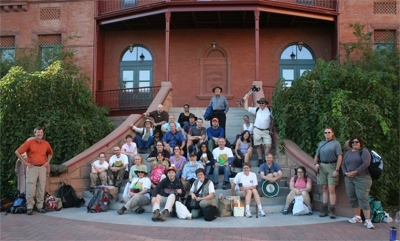IMCA Insights – November 2011
Arizona State University’s
Center for Meteorite Studies
Is 50 years old!
by Anne M. Black
The year was 1961, and it all began with Dr. Carleton Moore and Harvey H. Nininger.
Dr. Carleton Moore,
circa 1965
(Photo courtesy of ASU)
Arizona State College
was now Arizona State University, and with the name change came the goal
of emphasizing the research activities of the new university. The
Research Coordinator was George A. Boyd who was very familiar with the
Nininger Meteorite Collection. With a grant from the National Science
Foundation and additional funds from the International Nickel Company,
whose Vice-President, Herbert G. Fales was an avid meteorite collector.
The collection was bought on June 8, 1960 and moved from Sedona to
Tempe. Thus the Center for Meteorite Studies was created
Dr. Carleton Moore, who had recently completed a doctorate on the topic
of chemical groupings of chondrite meteorites at California Institute of
Technology, was appointed as the Center's first director. The original
collection was made up of 677 distinct meteorites and the primary
directive was that the meteorites must be “available primarily for
purposes of scientific research by qualified scientists throughout the
History of the Center”. Dr. Moore remembers that: “When I came there
were very few of us that knew anything about meteorites,” says Moore,
who was 29 years old when he began his career at ASU. “At that time, it
was mostly chemists who studied meteorites. In the beginning, we just
had a small room in the C-wing basement and everything was in steel
cases; that’s where they put the meteorites before I came. And then
chemistry abandoned a lecture room between the C wing and the B wing and
we were given part of that for the meteorites. We eventually moved again
to where the vault is now.”
After more than 40 years of dedicated service, Moore retired from ASU in
2003 but to this day he actively participates in the Center's education
and public outreach activities, and numerous public speaking engagements
that reach hundreds of educators, students and members of the public
each year.
Former NASA administrator Laurie Leshin was a professor in the ASU
department of geological sciences and an ASU alumna, when she was named
the new director after Moore retired. In 2006, Meenakshi “Mini” Wadhwa,
then curator of meteoritics at The Field Museum of Natural History in
Chicago, was named director of the Center and professor in the School of
Earth and Space Exploration in ASU's College of Liberal Arts and
Sciences. And then Laurence Garvie joined the Center as Curator of the
Meteorite Collection.
Dr. Meenakshi (Mini)
Wadhwa, Laurence Garvie
(Photo courtesy of Jim Woddell)
On October 21, 2011,
ASU celebrated the 50th year of the Center for Meteorite Studies with a
symposium attended by the Who's Who of the World of Meteoritics, and I
was invited.
Dr. Moore welcomed everybody with coffee and a short introduction, and
then we all settled to a full day of learning from the masters:
9:45 – Gerald W. Wasserburg – California Institute of Technology
Meteoritics and Cosmochemistry: A retrospective and Highlights
10:30 – Donald S. Burnett – California Institute of Technology
Importance of sample return missions to the advancement of
Cosmochemistry
11:15 – Andrew M. Davis – University of Chicago
The role of analytical advances in the advancement of Cosmochemistry
(or how the scientists are getting deeper and deeper into the
meteorites)
NOON LUNCH BREAK
1:45 – Caroline Smith – The Natural History Museum, London, UK
Meteoritics: The Significance of Collection and Curation on the State of
the Field
(or how the Curator of a State-owned facility maneuvers around and
through a tangled thicket of laws, rules and regulations, both domestic
and international)
2:30 – Philip R. Christensen – Arizona State University
The Complementarily of Remote-sensing and Laboratory Analyses in
Planetary Science
(or how the machines are taking over!!! And I thought that a electron
microscope was complex!, a toy compared to some of the machines of the
future!)
3:15 – Timothy J. McCoy – Smithsonian Institution
Meteoritics: Where will we be in 2061?
4:00 – Cocktail Reception, University Club
(or a great time to ask questions, and get to know a little about all
of those people)
Tim McCoy –
Smithsonian Museum
(Photo by Dolores Hill)
Mini Wadhwa and Jim
Wittke (NAU)
(Photo by Dolores Hill)
5:00 – Dinner Break
7:00 - Timothy J. McCoy – Smithsonian Institution
Dawn: A journey to the Birth of the Solar System.
Then Laurence Garvie opened the Vault, just a marvelous and very large
candy store for any meteorite enthusiast!
Dr. Mini Wadhwa in
the Vault
(Photo courtesy of ASU)
Holbrook "Peas"
(Photo courtesy of ASU)
Allende with embedded
gras
(Photo courtesy of ASU)
Bruno, close up
(Photo courtesy of ASU)
The next morning, most of us assembled bright and early on the steps of Old Main, with coffee, coolers and wearing sturdy walking shoes. We were all going to Meteor Crater for a very special grand tour of the whole site with commentaries and explanations by Laurence Garvie and Dr. Dave Kring who knows every corner of the whole crater from the bottom to the rim.
In front of Old Main
at ASU: Dr. D. Kring (left) and the whole group
(Photo courtesy of Rik Hill)
Words are truly insufficient to describe Meteor Crater, so allow me to describe it with pictures, after thanking Dr. Wendy Taylor (Assistant Director, R. S. Dietz Museum of Geology, School of Earth and Space Exploration, ASU) for allowing me to pick and choose through the 398 pictures she took on this day.
Time–out to enjoy the scenery
Of course, the whole of the crater
House-size rock
upturned (the layers are vertical instead of
horizontal) and deposited on the rim by the impact
Another example of
the force of the impact: this rock was turned
upside down (the older layers are on top, above the younger layers)
Layers of ejecta on
the outer slopes of the crater. In the distance:
San Francisco Mountain, the dormant volcano north of Flagstaff
Ruins of the mining
camp built for the employees
of Daniel M. Barringer a little over a century ago

(Photos courtesy of Wendy Taylor)
And now I
would like to thank very sincerely Mini Wadhwa, Laurence Garvie and all
the people of ASU who made me feel very welcome and who put together a
great celebration of their first 50 years. I wish them many, many more.
Anne M. Black
This article has been edited by Norbert Classen
•
IMCA Home Page •
IMCA Code of Ethics •
IMCA Member List
•
Join IMCA •
IMCA Meteorite Info














